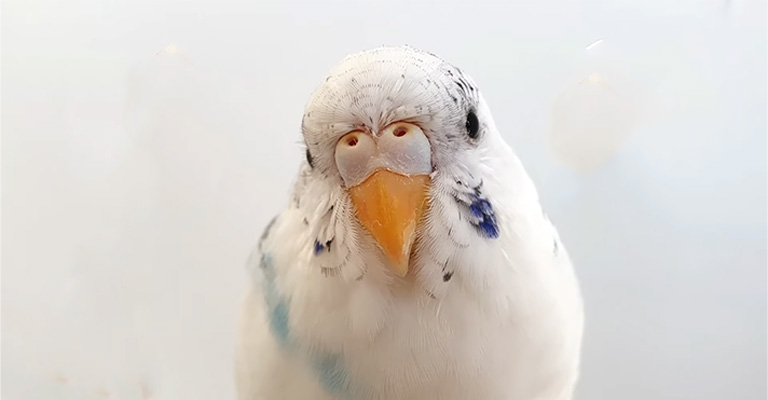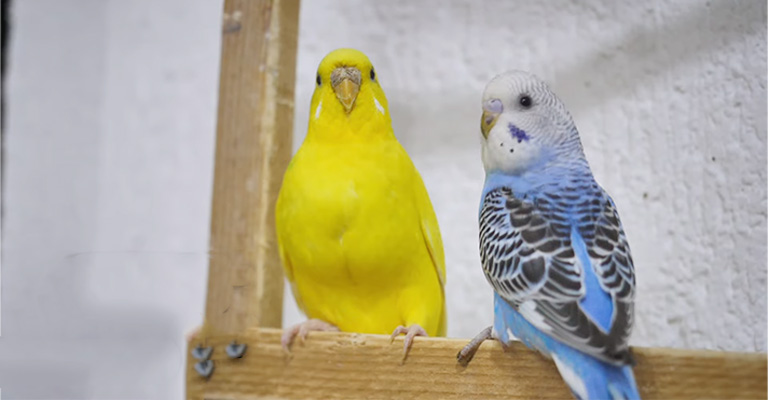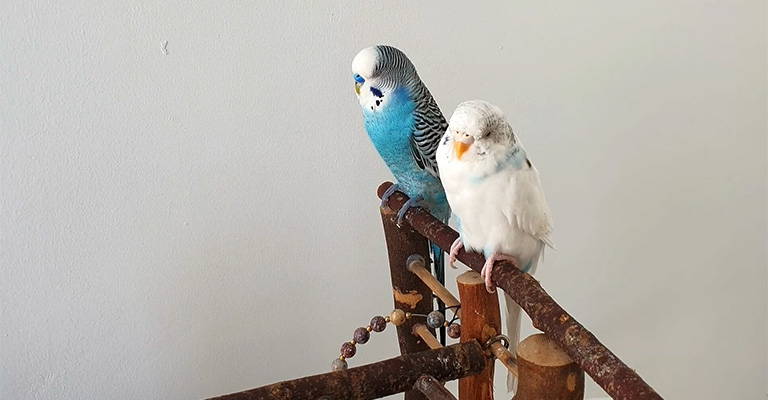Budgies, with their vibrant plumage and charming personalities, are a popular choice for bird enthusiasts. Whether you’re a seasoned budgie owner or a newcomer to the world of avian companionship, accurately identifying the gender of your budgies is a valuable skill.
While identifying the gender of budgerigars, or budgies for short, can be a skill that requires a keen eye and some patience, there are several key characteristics to look for when trying to identify a female budgie.
From subtle color variations to distinctive behavioral cues, there are several telltale signs that can help you confidently determine the gender of your feathered friend.
In this article, we’ll guide you through the key features and behaviors to learn ‘How do you identify a female budgie‘. With this knowledge, you’ll be better equipped to understand your budgie’s identity and provide tailored care to ensure her health and happiness.

How Do You Identify a Female Budgie?
Identifying a female budgie (also known as a hen) involves observing specific physical traits and behaviors. Here are some key indicators to help you identify a female budgie:
Cere Color
The cere is the area just above the beak where the nostrils are located. In most adult female budgies, the cere is typically light to medium brown, beige, or pale blue. However, during breeding or hormonal changes, the cere color might become darker and develop a crusty texture.
Behavior During Courtship
Female budgies often display receptive behavior when a male budgie is courting them. This includes crouching, tail lifting, and even regurgitating food in response to the male’s advances.
Nesting Behavior
Females tend to show nesting behaviors, such as exploring potential nesting sites, shredding paper or other materials, and displaying a general interest in nesting activities.
Egg-Laying Behavior
Of course, if you witness your budgie laying eggs, it’s a clear indication that she’s female. However, not all female budgies lay eggs, especially if they’re not exposed to the right conditions.
Body Size and Shape
In some cases, female budgies might have a slightly smaller and more streamlined body shape compared to males. However, this is a less reliable indicator as size and shape can vary among individuals.
Young budgies, especially those under 6 months of age, can be challenging to sex based on visual cues alone. As they mature, certain gender-specific traits become more evident.
Feather Patterns
In some budgies, there might be subtle differences in the feather patterns and distribution. However, this can vary greatly among individual budgies and might not always be a reliable indicator.
Behavior Towards Other Birds
Female budgies tend to have a more assertive or dominant demeanor when interacting with other birds, including other females. Males might display more courtship behavior.
Song and Vocalizations
While both male and female budgies can sing and vocalize, some experts believe that males might be slightly more inclined to sing and mimic sounds. However, this is not a foolproof method for identification.
Genetics and DNA Testing
For a definitive identification, especially with young or visually ambiguous budgies, DNA testing is the most accurate method. This involves sending a small blood sample for analysis to determine the bird’s genetic sex.
Remember that while these factors can provide clues, individual variations and exceptions exist. For precise identification, especially if you’re planning to pair budgies for breeding, consider seeking professional assistance through DNA testing or consulting with experienced avian enthusiasts or breeders.
How to Determine the Sex of a Young Budgie?

Determining the sex of a young budgie, especially those under 6 months of age, can be challenging due to the lack of fully developed gender-specific traits. However, there are methods you can use to make an educated guess:
Wait for Maturity
The most accurate way to determine a budgie’s sex is to wait until they reach sexual maturity, usually around 6 to 9 months of age. At this point, some gender-specific traits become more apparent.
Observe Behavior
While not foolproof, young male budgies might show slightly more playful and active behavior, while females might appear more assertive or dominant. However, individual personalities can vary greatly.
Cere Characteristics
Examine the cere (the area just above the beak) closely. In young budgies, both males and females have similar ceres that are usually a pale pink or purplish color. However, some experts believe that young females’ ceres might be slightly smoother in texture.
Observe Feather Patterns
Some breeders suggest that there might be subtle differences in feather patterns between young males and females, but this method is not widely reliable.
Consult Experienced Breeders
Experienced budgie breeders might be able to provide insights based on their observations, but even they might not be able to accurately sex young budgies without genetic testing.
DNA Sexing
The most accurate method to determine the sex of young budgies is through DNA testing. This involves sending a small blood sample for analysis to a specialized lab. DNA sexing is a reliable and definitive way to know a budgie’s gender, especially in young birds.
Keep in mind that young budgies can surprise you as they mature, and the early visual indicators might not always hold true. If you need to know the sex for breeding or other important purposes, DNA testing is recommended.
Otherwise, enjoy observing your budgie’s development and behaviors as they grow and reveal their true identity over time.
What Noises Do Female Budgies Make?

Female budgies, like their male counterparts, are known for their vocalizations and wide range of sounds. While their repertoire might not be as elaborate as that of males, female budgies can produce various noises. Here are some common noises female budgies make:
Chirping and Chattering
Female budgies often engage in chirping and chattering, which can be soft and melodious. These sounds are part of their natural communication and can indicate contentment or interaction with their surroundings.
Soft Warbling
Some female budgies emit soft warbling sounds, similar to singing. While not as complex as male budgie songs, these warbles are a form of communication.
Contact Calls
Female budgies use contact calls to communicate with their flock members or mates. These calls are shorter and often used to maintain contact when foraging or exploring.
Vocalizations During Courtship
When a female budgie is in the presence of a male that is courting her, she might respond with soft vocalizations. These sounds can be a sign of receptiveness to the male’s advances.
Alarm Calls
Like all budgies, females have alarm calls that they use to alert others in their group to potential dangers. These calls are typically louder and more urgent than their regular vocalizations.
Mimicking Sounds
While less common than in males, some female budgies can mimic sounds they hear in their environment, such as whistles, clicks, or other household noises.
Interactions with Cage Mates
Female budgies might engage in vocal interactions with other budgies in their cage. This can include playful chirping, back-and-forth calling, and other forms of social communication.
Note that individual budgies have unique personalities and vocal tendencies. Some female budgies might be more vocal than others. Additionally, the context in which these noises are produced can provide insights into their meaning.
By paying attention to your budgie’s vocalizations along with their body language and behaviors, you can gain a better understanding of their communication and emotions.
How to Care for a Female Budgie?

Caring for a female budgie (hen) involves providing a nurturing environment that caters to her unique needs. Here’s a comprehensive guide to help you care for your female budgie:
Appropriate Housing
Provide a spacious cage with horizontal bars that allow her to climb and move comfortably. Opt for a cage size of at least 18x18x18 inches. Add perches of varying diameters, and include toys and activities for mental stimulation.
Balanced Diet
Offer a well-rounded diet consisting of high-quality commercial budgie pellets, fresh vegetables, and a variety of bird-safe fruits. Provide seeds as a treat in moderation. Ensure access to clean, fresh water at all times.
Comfortable Resting Space
Place a comfortable nesting box or sleeping shelter in her cage. Provide clean, non-toxic nesting materials such as paper strips or coconut fibers if she displays nesting behaviors.
Social Interaction
Budgies are social birds; ensure she has companionship, either from other budgies or through regular interaction with you. Social interactions prevent loneliness and encourage mental stimulation.
Regular Out-of-Cage Time
Let her explore and stretch her wings in a safe, supervised space outside the cage. This time allows her to exercise, fly, and interact with you.
Environmental Enrichment
Rotate toys and provide various types of toys, including climbing toys, puzzle toys, and toys that encourage foraging behaviors. This prevents boredom and promotes mental engagement.
Routine Veterinary Care
Schedule regular check-ups with an avian veterinarian to monitor her health. Establish a baseline and keep track of her weight, behavior, and overall well-being.
Grooming and Hygiene
Budgies are clean birds; provide a shallow dish of water for her to bathe in. Trim her nails and wings as needed, or seek professional grooming services.
Natural Light and Sleep
Ensure she receives natural sunlight or full-spectrum UV lighting for a few hours each day to support her overall health. Cover her cage at night to provide a quiet, dark environment for sleep.
Mental Stimulation
Offer opportunities for mental exercise through interactive toys, challenges, and games that mimic natural behaviors like foraging.
Remember that not all female budgies will lay eggs. If she shows nesting behaviors, provide nesting materials, but avoid excessive handling or disruption around the nesting area.
Watch for Signs of Illness
Be vigilant for signs of illness, such as changes in appetite, behavior, or droppings. Seek immediate veterinary care if you notice any concerning changes.
By providing a well-rounded environment that caters to her physical, mental, and social needs, you’ll create a fulfilling and comfortable life for your female budgie.
FAQs
In general, female budgies tend to have less vibrant and bright plumage compared to males.
This is because males often display more intense colors to attract potential mates. However, some female budgies might still have beautiful and distinct coloring.
While there might be slight differences in size between males and females, this is not a reliable method for sexing budgies.
Individual variation, age, and genetics can influence their size, making it challenging to determine gender solely based on this factor.
Yes, female budgies are capable of learning to talk and mimic sounds, just like male budgies.
The ability to talk is not strictly gender-dependent but varies among individual budgies based on their inclination and exposure to sounds.
Yes, female budgies can lay eggs even without a male present. This is known as “egg-laying without mating.” In such cases, the eggs are infertile and won’t hatch into chicks.
Providing a comfortable nesting area and monitoring their egg-laying behavior is important to prevent complications.
Yes, DNA testing is the most accurate method to determine a budgie’s gender, especially for young birds or those with subtle visual differences.
A small blood sample is analyzed to determine the bird’s genetic sex, providing a definitive answer without any guesswork.
Conclusion
Identifying a female budgie involves a combination of visual cues, behavioral observations, and understanding the subtle differences in their appearance. While the process might seem complex, it’s a rewarding endeavor that deepens your connection with your budgie.
By recognizing the specific characteristics that indicate a female budgie, you can enhance your ability to care for her unique needs.
From the subtle hues of her cere to her behavior during courtship and nesting, these cues provide insights into her gender and contribute to a holistic understanding of her well-being.
Remember that each budgie is an individual, and variations can exist even within the same gender.
Armed with this knowledge, you’re better equipped to provide the best possible care for your female budgie, fostering a relationship built on trust, companionship, and the joy of shared experiences.